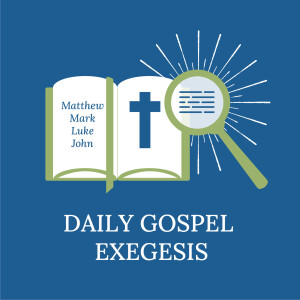
To support the ministry and access exclusive content, go to: http://patreon.com/logicalbiblestudy
For complete verse-by-verse audio commentaries from Logical Bible Study, go to: https://mysoundwise.com/publishers/1677296682850p
John 1: 29-34 - 'Look: there is the lamb of God.'
Catechism of the Catholic Church Paragraphs:
- 408 (in 'A Hard Battle') - The consequences of original sin and of all men’s personal sins put the world as a whole in the sinful condition aptly described in St. John’s expression, “the sin of the world" (abbreviated)
- 438 (in 'Christ') - His eternal messianic consecration was revealed during the time of his earthly life at the moment of his baptism by John, when “God anointed Jesus of Nazareth with the Holy Spirit and with power,” “that he might be revealed to Israel" (abbreviated)
- 486 (in 'Who Was Conceived by the Holy Spirit') - The Father’s only Son, conceived as man in the womb of the Virgin Mary, is “Christ,” that is to say, anointed by the Holy Spirit, from the beginning of his human existence, though the manifestation of this fact takes place only progressively: to the shepherds, to the magi, to John the Baptist, to the disciples
- 523 (in 'The Preparations') - He inaugurates the Gospel, already from his mother’s womb welcomes the coming of Christ, and rejoices in being “the friend of the bridegroom,” whom he points out as “the Lamb of God, who takes away the sin of the world" (abbreviated)
- 536 (in 'The Baptism of Jesus') - The baptism of Jesus is on his part the acceptance and inauguration of his mission as God’s suffering Servant. He allows himself to be numbered among sinners; he is already “the Lamb of God, who takes away the sin of the world.” Already he is anticipating the “baptism” of his bloody death. Already he is coming to “fulfill all righteousness,” that is, he is submitting himself entirely to his Father’s will: out of love he consents to this baptism of death for the remission of our sins. The Father’s voice responds to the Son’s acceptance, proclaiming his entire delight in his Son. The Spirit whom Jesus possessed in fullness from his conception comes to “rest on him.” Jesus will be the source of the Spirit for all mankind. At his baptism “the heavens were opened”—the heavens that Adam’s sin had closed—and the waters were sanctified by the descent of Jesus and the Spirit, a prelude to the new creation.
- 608 (in 'The Lamb who takes away the sin of the world') - After agreeing to baptize him along with the sinners, John the Baptist looked at Jesus and pointed him out as the “Lamb of God, who takes away the sin of the world.” By doing so, he reveals that Jesus is at the same time the suffering Servant who silently allows himself to be led to the slaughter and who bears the sin of the multitudes, and also the Paschal Lamb, the symbol of Israel’s redemption at the first Passover. Christ’s whole life expresses his mission: “to serve and to give his life as a ransom for many.”
- 613 (in 'Christ's death is the unique and definitive sacrifice') - Christ’s death is both the Paschal sacrifice that accomplishes the definitive redemption of men, through “the Lamb of God, who takes away the sin of the world" (abbreviated)
- 719 (in 'John, Precursor, Prophet & Baptist') - In John’s sight, the Spirit thus brings to completion the careful search of the prophets and fulfills the longing of the angels. “He on whom you see the Spirit descend and remain, this is he who baptizes with the Holy Spirit. And I have seen and have borne witness that this is the Son of God. . . . Behold, the Lamb of God" (abbreviated)
- 1137 (in 'The celebrants of the Heavenly liturgy')
- 1286 (in 'Confirmation in the Economy of Salvation')
- 1505 (in 'Christ the Physician')
More Episodes
Create your
podcast in
minutes
- Full-featured podcast site
- Unlimited storage and bandwidth
- Comprehensive podcast stats
- Distribute to Apple Podcasts, Spotify, and more
- Make money with your podcast
It is Free
- Privacy Policy
- Cookie Policy
- Terms of Use
- Consent Preferences
- Copyright © 2015-2024 Podbean.com







